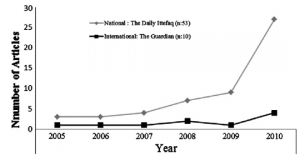The tiger and the media

The tiger is the most famous animal in Bangladesh and it’s awesome power is why it has been named the National Animal of Bangladesh. However the tiger is under threat due to habitat fragmentation, climate change and challenges of sharing the Sundarbans with the 1.5 million people who depend on the forest for their livelihood.
International support for the tiger is strong and Bangladesh and the Sundarbans receive international media coverage as being the last stronghold of the Bengal tiger. In a recent study, by staff from Khulna University, Bangladesh, has found that media coverage of the tiger both locally and internationally has increased in recent years.
The study found that international media are more likely to include articles sympathetic to the tiger and that increase in human-tiger conflict was due to habitat loss and climate change in the Sundarbans:
“Climate change is a reality in the Sundarbans. Rising sea levels, constant erosion and increasingly salty waters make life in the tangle of islands and mangrove forest harder for animals”,[1]
“..the primary cause of tiger death – like many of the big cats – people killing tiger themselves and people killing their food”[2]
While local media were focused more on the human victims of human-tiger conflict, for example:
“A woman was killed in a tiger attack in the Dhanbari village in Mongla upazila on Monday evening. The woman was identified as Sathia Begum, 45, of the Rekhamari village of the upazila” [3]
The study highlighted that media coverage shapes people views of tigers and that it was important to find a middle ground between the view that people kill tigers or that tigers kill people.
[1] Vidal, J. 2008. ‘There are many tiger widows here’ The Guardian 25 September 2005 http://www.guardian.co.uk/environment/2008/sep/25/conservation.climatechange
[2] The Guardian, 19 February 2010
[3] The Daily Ittefaq, 12 July 2010


